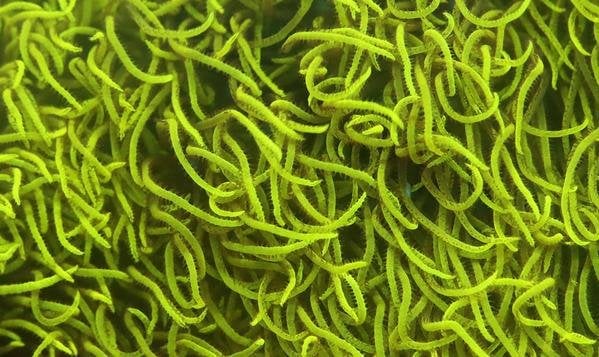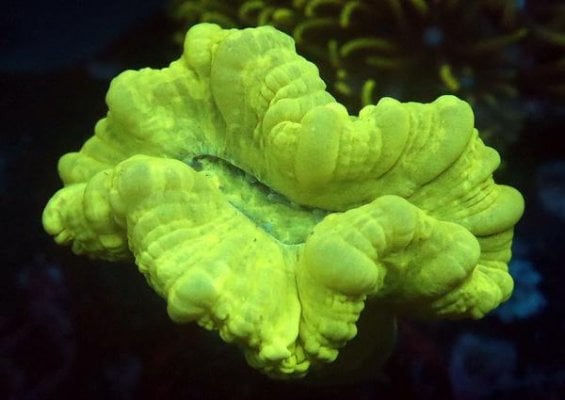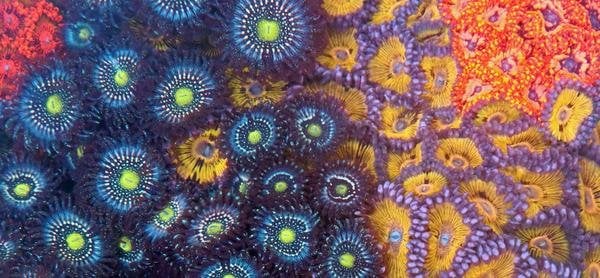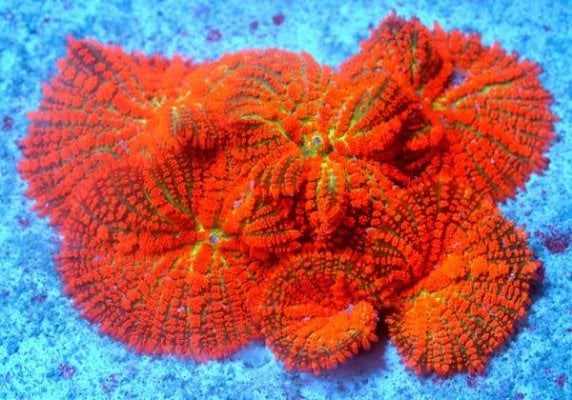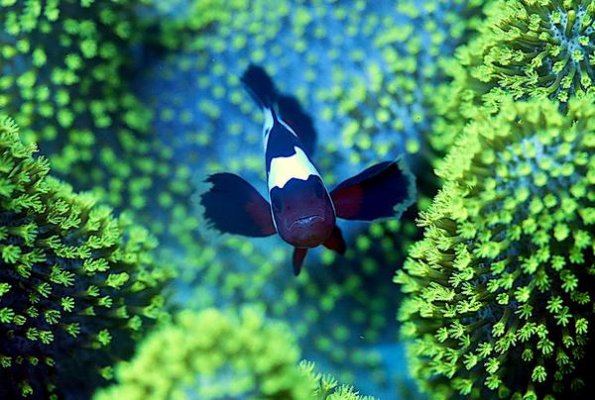Corals have beautiful colorations, whether you are after soft corals, LPS corals, or SPS corals, we believe there is a coral out there for everyone!
When choosing corals, you want to ensure they are healthy so they get the best start to their new life inside your reef tank. At R2R, our coral frags are grown to their full potential and quality because we believe “that happy, healthy corals lead to even happier customers”.
When choosing corals you want to look at:
Popular soft corals include Zoanthids, Ricordia, Xenia, and Mushrooms. These corals are known to be successful in newer tanks, as they only require moderate light and water demands. They are also more forgiving to water quality making them easier to care for, while also quickly adding color and movement to any reef tank.
LPS coral are overall more difficult to care for than softies, as they have a calcium carbonate structure, pulling elements such as calcium and carbonate from the water, to build their structure.
You will need to maintain these elements for LPS corals to grow. Water changes will do this at the beginning, but as they grow you will likely need to dose the water to encourage further growth.
SPS corals are considered more demanding, requiring medium to intense lighting, high-quality water conditions, and a more intense water flow (usually with a random circulation). They are known to consume calcium and carbonate from the water quite rapidly, so you will need to frequently dose trace elements in the water. Most aquarium hobbyists use calcium reactors to do this.
SPS is for more advanced and experienced hobbyists. As such, we do not recommend this type of corals for beginners. However if you have already had success keeping softies and LPS corals, and are ready to take the plunge.

Popular for first-time buyers, these attractive and almost indestructible corals, are inexpensive and super easy to find in the aquarium trade.
While their colors differ, their general appearance is the same, consisting of a cluster of star-shaped polyps, hence the name!

Boasting bright colors, and known to adapt to light and water flow conditions, these are one of our favorites for reef tanks.
Leather corals often coat themselves in a waxy substance, do not worry, this is their natural way of cleaning.
But beware, they can sting other corals, so if you do choose a leather coral, ensure they have plenty of space between others in the reef tank.

These soft corals do not like intense lighting and a strong water flow, despite that they are pretty hardy so make a great choice for beginner hobbyists.
When extended, their long tentacles can sometimes damage other corals in the tank, so provide them with ample space.

These are very colorful, usually displaying a two-tone or ‘ombre’ color, and are also a great choice for beginner reef keepers.
They do best with intense lighting, however, they are also comfortable growing in lower light conditions with a moderate to strong water flow.
They can become quite aggressive and some species contain a powerful neurotoxin called “palytoxin” that can be harmful to humans. Always handle them with care and wear gloves!

Extremely popular with novice aquarists, trumpet corals come in a variety of not only colors but also patterns!
Usually green with some having a bluish tone, trumpets catch the eye of anyone passing by. The name comes from their trumpet-shaped polyps that form into a beautiful branching colony.
They do best with medium to high light exposure but are more forgiving with water quality than other stony corals.
NOTE: When mixing corals, some will not get along with others and are often seen fighting for space and food.
There is no “perfect way” to set up a reef tank, but with our experience over the years, we have our best advice to get you going on your reef aquarium journey!
Small fluctuations in water parameters can cause a major cause of concern for coral survival. Testing the water frequently and dosing the water with live nitrifying bacteria, will give your corals a fighting chance of survival inside your reef tank.
Ideal water parameters for corals:
Most easy corals are “zooxanthellate” which means they contain photosynthetic organisms called Zooxanthellae. These organisms live inside the coral’s tissues and require lighting to function.
SPS and LPS corals will require more light than soft corals which will help you decide where to put them in your reef tank and to choose which corals you wish to keep. For example, you may only have a small rock formation inside which will not be exposed to intense lighting and a strong water flow, so soft corals would be your go-to.
Going back to the “pyramid system”, you can see that when it comes to choosing corals for a reef tank, placement has a large influence on the water flow requirements.
When choosing corals, you want to ensure they are healthy so they get the best start to their new life inside your reef tank. At R2R, our coral frags are grown to their full potential and quality because we believe “that happy, healthy corals lead to even happier customers”.
When choosing corals you want to look at:
- Their coloration - they should be bright and healthy-looking.
- The placement and type of current and circulation the frags are kept in - this gives you an idea of what they will like, and if they will thrive in your reef tank at home.
- That the corals are fully extended, the polyps are open, healthy, and happy looking.
Soft Corals (Softies) for Reef Tanks
Generally, the easier ones and the most common among aquarium hobbyists to start with. Not only do they do relatively well in every reef tank, but there are also so many different kinds!Popular soft corals include Zoanthids, Ricordia, Xenia, and Mushrooms. These corals are known to be successful in newer tanks, as they only require moderate light and water demands. They are also more forgiving to water quality making them easier to care for, while also quickly adding color and movement to any reef tank.
LPS (Large Polyp Stony) Corals for Reef Tanks
These have a calcium carbonate structure, with large polyps attached to them.LPS coral are overall more difficult to care for than softies, as they have a calcium carbonate structure, pulling elements such as calcium and carbonate from the water, to build their structure.
You will need to maintain these elements for LPS corals to grow. Water changes will do this at the beginning, but as they grow you will likely need to dose the water to encourage further growth.
SPS (Small Polyp Stony) Corals for Reef Tanks
Many would agree, these are the most difficult to keep. They also have a calcium carbonate structure, but they have much smaller polyps that only appear when water conditions are right.SPS corals are considered more demanding, requiring medium to intense lighting, high-quality water conditions, and a more intense water flow (usually with a random circulation). They are known to consume calcium and carbonate from the water quite rapidly, so you will need to frequently dose trace elements in the water. Most aquarium hobbyists use calcium reactors to do this.
SPS is for more advanced and experienced hobbyists. As such, we do not recommend this type of corals for beginners. However if you have already had success keeping softies and LPS corals, and are ready to take the plunge.
Recommended Corals for Reef Tanks
So, from the categories above, we selected these 5 reef tank corals that are friendly for beginners thanks to them being a little more hardy and forgiving than other species!Star Polyps (Pachyclavularia)

Popular for first-time buyers, these attractive and almost indestructible corals, are inexpensive and super easy to find in the aquarium trade.
While their colors differ, their general appearance is the same, consisting of a cluster of star-shaped polyps, hence the name!
Leather Corals (Sarcophyton, Lobophytum & Sinularia)

Boasting bright colors, and known to adapt to light and water flow conditions, these are one of our favorites for reef tanks.
Leather corals often coat themselves in a waxy substance, do not worry, this is their natural way of cleaning.
But beware, they can sting other corals, so if you do choose a leather coral, ensure they have plenty of space between others in the reef tank.
Mushroom Corals (Actinodiscus)

These soft corals do not like intense lighting and a strong water flow, despite that they are pretty hardy so make a great choice for beginner hobbyists.
When extended, their long tentacles can sometimes damage other corals in the tank, so provide them with ample space.
Zoanthids & Zoanthus Button Polyps (Zoanthus)

These are very colorful, usually displaying a two-tone or ‘ombre’ color, and are also a great choice for beginner reef keepers.
They do best with intense lighting, however, they are also comfortable growing in lower light conditions with a moderate to strong water flow.
They can become quite aggressive and some species contain a powerful neurotoxin called “palytoxin” that can be harmful to humans. Always handle them with care and wear gloves!
Trumpet Coral (Caulastrea furcata)

Extremely popular with novice aquarists, trumpet corals come in a variety of not only colors but also patterns!
Usually green with some having a bluish tone, trumpets catch the eye of anyone passing by. The name comes from their trumpet-shaped polyps that form into a beautiful branching colony.
They do best with medium to high light exposure but are more forgiving with water quality than other stony corals.
NOTE: When mixing corals, some will not get along with others and are often seen fighting for space and food.
All You Need to Know About Reef Tanks
Now you have an idea of what corals to choose, you are going to want to create the perfect environment for your corals, and that starts with the tank.There is no “perfect way” to set up a reef tank, but with our experience over the years, we have our best advice to get you going on your reef aquarium journey!
What Are Reef Tanks?
Reef tanks are saltwater aquariums that are largely dominated by coral coverage. Corals are photosynthetic organisms that require light, pristine water conditions, and a water flow to survive. Depending on the type of coral you will choose for your reef tank, depends on how much light and water flow they need to survive.What do Corals Need to Survive?
Once you have chosen corals for your reef tank, it is important to maintain them. When it comes to corals needs, we can separate them into 4 categories:- Water quality
- Light
- Water flow/movement
- Food
Water Quality
Corals are sensitive to changes in water quality, especially ammonia and nitrite. Ammonia is the most common toxin that causes problems in aquariums, so always keep a close eye on ammonia levels until your tank is well established.Small fluctuations in water parameters can cause a major cause of concern for coral survival. Testing the water frequently and dosing the water with live nitrifying bacteria, will give your corals a fighting chance of survival inside your reef tank.
Ideal water parameters for corals:
- Ammonia: 0 ppm
- Nitrite: 0 ppm
- pH: 8.2-8.4
- Nitrate: <10 ppm
Light
Next to think about is the amount of light your corals will be exposed to. The amount of lighting depends on what species of coral you choose to keep in your reef tank.Most easy corals are “zooxanthellate” which means they contain photosynthetic organisms called Zooxanthellae. These organisms live inside the coral’s tissues and require lighting to function.
SPS and LPS corals will require more light than soft corals which will help you decide where to put them in your reef tank and to choose which corals you wish to keep. For example, you may only have a small rock formation inside which will not be exposed to intense lighting and a strong water flow, so soft corals would be your go-to.
Water Flow/Movement
Water requirements differ between species. What corals you should choose will depend on your tank arrangement and water flow.Going back to the “pyramid system”, you can see that when it comes to choosing corals for a reef tank, placement has a large influence on the water flow requirements.
Food
In terms of food for corals, it comes in many different forms. Most corals (zooxanthellate corals) will get sufficient food from lighting, while others will need a little help from direct or indirect feeding to consume vital nutrients for growth.- Mixed corals: liquid or powder form.
- LPS corals: pellet or powder-formed food.
- SPS corals: as they are exposed to intense lighting, they get the majority of nutrients from this, but most reef keepers will add amino acids to encourage tissue growth and enhance their colorations.




